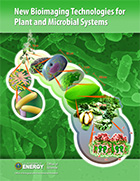Mission
The U.S. Department of Energy’s (DOE) Office of Biological and Environmental Research (BER) supports fundamental research to advance a predictive understanding of complex biological and environmental systems relevant to DOE’s missions in energy and the environment. Starting with the genetic potential encoded by organisms’ genomes, BER scientists seek to define the principles guiding translation of the genetic code into functional proteins and the metabolic and regulatory networks underlying plant and microbial systems. Concurrent with this research is a need for enabling technologies to place understanding of gene expression, regulation, and function into the spatiotemporal context of whole-cell environments. Imaging and measurement technologies that can resolve multiple key metabolic processes over time within or among cells will act as a crucial bridge toward linking molecular-scale information to whole-cell, systems-level understanding.
Program Goals
Bioimaging and measurement technologies that can resolve multiple key metabolic processes over time within or among cells will act as a crucial bridge toward linking molecular-scale information to whole-cell, systems-level understanding. Department of Energy (DOE) Office of Science’s Office of Biological and Environmental Research (BER) supports research into enabling technologies to place understanding of gene expression, regulation, and function into the spatiotemporal context of whole-cell environments.
Program Objectives
This new technology development effort in BER is targeted at creating novel multifunctional technologies to image, measure, and model key metabolic processes within and among microbial cells and multicellular plant tissues. BER’s current focus on developing a scientific basis for plant biomass-based biofuel production requires detailed understanding of cellular metabolism to incorporate, modify, or design beneficial properties into bioenergy-relevant plants and microbes. Likewise, the ability to track materials and chemical exchanges within and among cells and their environment is crucial to understanding the activity of microbial communities in environmental settings. New imaging and measurement technologies that can characterize multiple metabolic transformations will provide the integrative systems-level data needed to gain a more predictive understanding of complex biological processes relevant to BER.
The Bioimaging Science Program within the DOE Biological and Environmental Research (BER) Program, sponsors research at national laboratories and universities that addresses grand challenges for biology. The program’s mission is to understand translation of genomic information into the mechanisms that power living cells, communities of cells, and whole organisms. The program’s goal is to develop new imaging and measurement technologies to visualize the spatial and temporal relationships of key metabolic processes governing phenotypic expression in plants and microbes. Annual program PI meetings are intended to convene investigators contributing to the program and review progress and the current state-of-the-art in bioimaging research https://www.genomicscience.energy.gov/bioimaging-science-program/.
Funding Opportunities
Funding opportunities are posted at Grants.gov.
See Funding Opportunities for more details.
Contact
Program Manager
Paul Sammak, Ph.D.
Biological and Environmental Research
Office of Science
U.S. Department of Energy
[email protected]
Mailing Address
Office of Science
Office of Biological and Environmental Research
Biological Systems Science Division
U.S. Department of Energy
1000 Independence Ave., SW
Washington, DC 20585-1290








